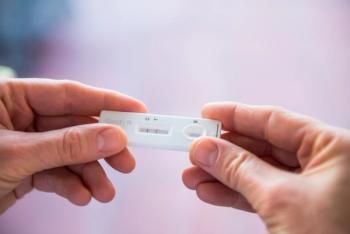
Vaginal Cuff Closure with Abdominal Hysterectomy
From ACOG - Philadelphia, Pennsylvania - May, 1999
Barbara Nesbitt: "Good afternoon, we are at ACOG, and I have the pleasure of interviewing Dr. Trevor Watson, from Columbia, Missouri. He's just done his presentation on the vaginal cuff closure with abdominal hysterectomy. I spoke with him yesterday, it's a new approach, sutures instead of clamps, and it sounds really, really good to me. Good afternoon, doctor."
Dr. Trevor Watson: "Thank you. I've been asked to come back yearly for presenting this at a round table at lunch, and I enjoy this. I usually make a bet with the first one that shows up to the table as to a mix of men and women, and I'm always right because there's always more women than men. And the reason - who has dyspareunia?"
Barbara Nesbitt: "Women."
Dr. Trevor Watson: "Women - that's right - and why do women have dyspareunia - for various reasons, they have pain with sexual activity, and very often that pain emanates after a hysterectomy. What we have tried to do here is to eliminate that problem. We are trying to accomplish other things, one of those things is give the woman more support, we're trying to reduce the blood loss with our procedure, we're trying to show a method by which we can take out that uterus, close that cuff in a side to side manner so that this woman does not have any shortening whatsoever of the vaginal vault."
Barbara Nesbitt: "We have that whole section on OBGYN.net that I showed you yesterday that's directed towards the women patients, and we have a great forum on there. Over the last two years, I have to tell you - I was ignorant of that fact. I had a hysterectomy, and I never had that problem. When women would write in, I have to tell you, I didn't understand what they were talking about. But after talking with you yesterday and you drawing pictures and showing me things, I now can understand. Tell them what happens to women."
Dr. Trevor Watson: "Starting in 1926, there was a description in the literature about closure of the vaginal cuff from the abdominal approach, which essentially is a front-to-back closure. The front-to-back closure leaves a scar in a transverse manner at the end of the vaginal vault, and that scar very frequently is very tender. Now for other reasons some surgeons do not close the vaginal cuff but let it granulate an end. Granulation tissue leaves a tender scar, when this is at the end of the vaginal vault - you've left a woman with dyspareunia too."
Barbara Nesbitt: "Now can you get adhesions from that scar?"
Dr. Trevor Watson: "Not so much, but you have a tender area there, and you know that old saying that the vaginal vault will accommodate sexual activity after hysterectomy even if you do shorten it - is not right. But this problem happens because doctors put a clamp around the end of the vagina, and then cut off the vagina. Measuring specimens that have been taken this way, you'll find a 2-4 centimeter rim of vagina around the cervix, then you further close it from front-to-back - you have further shortened it, and left the scar right there where deep penetration is…"
Barbara Nesbitt: "Is hitting."
Dr. Trevor Watson: "If it doesn't hit the scar, it's pulling against the scar. So what I wanted to describe to you is how to avoid that and how to close that in a sagittal or side-to-side manner."
Barbara Nesbitt: "You showed me yesterday - it is so wonderfully simple."
Dr. Trevor Watson: "Yes, I would like to be able to send a monograph to anybody that is interested in this, and I would be happy to do so at no cost. Now, the method involves - when you get down to taking down the cardinal ligaments and you've divided them from the cervix, before you take off your clamps, you want to take a suture through your cardinal - but don't tie it. You hold it, and put a clamp on it on both sides. Then take a another suture, and an #O Vicryl -MO4 needle is usually what I use, and go in that angle. Try to go underneath the vaginal mucosa and bring it back through the center of your clamp, underneath the center part of your clamp, and then hold that. It doesn't matter if you miss and go all the way into the vaginal vault - it's not important. But at any rate, tie down your cardinal, and then tie this suture which is controlling your lateral vaginal plexus of vessels. Or do that on both sides, and then enter your vagina at the reflection from the cervix. Cut it off with your Jorgenson scissors all away around, and you've left as much room on that vagina as you can. Now the matter is just taking those sutures you've left from the lateral vaginal plexus, going through the endopelvic fascia and the mucosa, out the mucosa on the other side, and use the other one coming on this side and pull on them. It pulls your vagina together from a side-to-side manner."
Barbara Nesbitt: "Rather than..."
Dr. Trevor Watson: "Rather from front-to-back and then use one suture to close the anterior parts. When you come back, bring the endopelvic fascia back over your cuff, and tie those sutures in the middle. Let your bladder come back, and you will find that it tents your bladder because you've given support under your bladder. If you have sutured that bloody angle and not put a clamp on it and then tried to get it, you'd be surprised your blood loss will be much less. Now there are sometimes varices in this area, you can clamp or you can suture, use a figure of eight suture on this cuff with impunity. Your ureters are way out of the way. They have been reflected when you take your bladder away. They're off to the sides, you have no worry about those ureters."
Barbara Nesbitt: "You know, Dr. Watson, we're going to put your monograph up along with this video on the website. We're going to have the diagrams so the physicians will be able to see how the placement of the sutures are. From a woman's standpoint, how does she find a physician that will do this? Can she read it and know about it, and go and talk to a physician? How does a woman - I had a hysterectomy, I didn't know, I'm fine so maybe they did use it…"
Dr. Trevor Watson: "I think it's very hard for a patient to tell a doctor how to do something."
Barbara Nesbitt: "Can she ask him if he does it?"
Dr. Trevor Watson: "She can ask."
Barbara Nesbitt: "Can she ask him if he's familiar with it?"
Dr. Trevor Watson: "She could."
Barbara Nesbitt: "You know, we're educating women, and in the process we're educating physicians as you're trying to do."
Dr. Trevor Watson: "We trying to educate physicians, and we're trying to get them to understand. Now I won a nickel at the table today because I bet the first lady that was there, there'd be more women than men in the mix. The mix was three men and seven women."
Barbara Nesbitt: "They're potentially hysterectomy candidates themselves."
Dr. Trevor Watson: "Women understand dyspareunia."
Barbara Nesbitt: "That's right."
Dr. Trevor Watson: "And most men don't because most men don't ask. They don't ask if they're depressed, and they don't ask if they have dyspareunia."
Barbara Nesbitt: "No they don't. I want to tell you one thing, I think one of the better things about having done this post-surgery is the fact that you're going to make a lot of couples very happy. I mean, there's married couples that have been married thirty or forty years, and all of a sudden the woman doesn't want to have sex with the man she loves and has lived with, and he can't understand it."
Dr. Trevor Watson: "That's right."
Barbara Nesbitt: "So this is a wonderful procedure."
Dr. Trevor Watson: "I could make some other comments. Occasionally while a patient is still in the hospital there may be a question whether or not she's developing a hematoma beneath this area. I'll tell you that you can put your hand in the vagina vault, and put it back as far as you will without hurting the patient. Now if you have bleeding or you have inflammation at the time you do the hysterectomy, it's easy to put a Jackson-Pratt drain in the center of that cuff. It's very simple to do that, and that will keep you out of trouble."
Barbara Nesbitt: "This is done with an abdominal hysterectomy. Just in case anybody missed this, everything is going down through the opening in the abdomen - so that's why the vagina is not then ended or like in a vaginal hysterectomy."
Dr. Trevor Watson: "That's right."
Barbara Nesbitt: "So you can do that examination and know that everything is all right there. Thank you, Dr. Watson."
Dr. Trevor Watson: "You're welcome."
Barbara Nesbitt: "It's been a pleasure."
Dr. Trevor Watson: "Thank you very much. I hope this helps women, and I hope this helps doctors help women."
Barbara Nesbitt: "I'm just a bit of a devil, and I think that women should ask around, and see if their doctor does it. They can even tell their doctor to check it out on OBGYN.net."
Newsletter
Get the latest clinical updates, case studies, and expert commentary in obstetric and gynecologic care. Sign up now to stay informed.
















